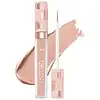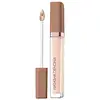What's inside
What's inside
 Key Ingredients
Key Ingredients

 Benefits
Benefits

 Concerns
Concerns

 Ingredients Side-by-side
Ingredients Side-by-side

Water
Skin ConditioningDimethicone
EmollientPropanediol
SolventTrimethylsiloxysilicate
EmollientIsododecane
EmollientGlycerin
HumectantCetyl PEG/PPG-10/1 Dimethicone
EmulsifyingPhenyl Trimethicone
Skin ConditioningPEG-10 Dimethicone
Skin ConditioningTriethoxycaprylylsilane
Aluminum Starch Octenylsuccinate
AbsorbentPolyglyceryl-3 Diisostearate
EmulsifyingPolypropylene
Vitis Vinifera Seed Oil
EmollientBakuchiol
AntimicrobialDiamond Powder
AbrasiveNiacinamide
SmoothingPassiflora Edulis Seed Oil
EmollientHydrolyzed Vegetable Protein
Skin ConditioningTocopherol
AntioxidantRubus Chamaemorus Fruit Extract
AntioxidantCaffeine
Skin ConditioningAloe Barbadensis Leaf Extract
EmollientLeuconostoc/Radish Root Ferment Filtrate
AntimicrobialCitrullus Lanatus Fruit Extract
Skin ConditioningCitrus Limon Fruit Extract
MaskingEuterpe Oleracea Fruit Extract
Fragaria Vesca Fruit Extract
AstringentLycium Barbarum Fruit Extract
AstringentMalpighia Punicifolia Fruit Extract
AntioxidantPassiflora Incarnata Fruit Extract
Skin ConditioningPrunus Persica Fruit Extract
AbrasivePunica Granatum Fruit Extract
AntioxidantVaccinium Angustifolium Fruit Extract
Skin ProtectingVaccinium Macrocarpon Fruit Extract
AstringentSodium Hyaluronate
HumectantKaolin
AbrasivePhenoxyethanol
PreservativeSilica
AbrasiveDisteardimonium Hectorite
StabilisingHydrogenated Polyisobutene
EmollientMagnesium Sulfate
Sodium Chloride
MaskingSorbitan Sesquiisostearate
EmulsifyingPropylene Carbonate
SolventPolysilicone-11
Ethylhexylglycerin
Skin ConditioningTocopheryl Acetate
AntioxidantPentaerythrityl Tetra-Di-T-Butyl Hydroxyhydrocinnamate
AntioxidantAlumina
AbrasiveSodium Ferrocyanide
Iron Oxides
CI 77891
Cosmetic ColorantCI 77288
Cosmetic ColorantWater, Dimethicone, Propanediol, Trimethylsiloxysilicate, Isododecane, Glycerin, Cetyl PEG/PPG-10/1 Dimethicone, Phenyl Trimethicone, PEG-10 Dimethicone, Triethoxycaprylylsilane, Aluminum Starch Octenylsuccinate, Polyglyceryl-3 Diisostearate, Polypropylene, Vitis Vinifera Seed Oil, Bakuchiol, Diamond Powder, Niacinamide, Passiflora Edulis Seed Oil, Hydrolyzed Vegetable Protein, Tocopherol, Rubus Chamaemorus Fruit Extract, Caffeine, Aloe Barbadensis Leaf Extract, Leuconostoc/Radish Root Ferment Filtrate, Citrullus Lanatus Fruit Extract, Citrus Limon Fruit Extract, Euterpe Oleracea Fruit Extract, Fragaria Vesca Fruit Extract, Lycium Barbarum Fruit Extract, Malpighia Punicifolia Fruit Extract, Passiflora Incarnata Fruit Extract, Prunus Persica Fruit Extract, Punica Granatum Fruit Extract, Vaccinium Angustifolium Fruit Extract, Vaccinium Macrocarpon Fruit Extract, Sodium Hyaluronate, Kaolin, Phenoxyethanol, Silica, Disteardimonium Hectorite, Hydrogenated Polyisobutene, Magnesium Sulfate, Sodium Chloride, Sorbitan Sesquiisostearate, Propylene Carbonate, Polysilicone-11, Ethylhexylglycerin, Tocopheryl Acetate, Pentaerythrityl Tetra-Di-T-Butyl Hydroxyhydrocinnamate, Alumina, Sodium Ferrocyanide, Iron Oxides, CI 77891, CI 77288
Water
Skin ConditioningCI 77891
Cosmetic ColorantBis-Stearyl Dimethicone
EmollientCaprylyl Methicone
Skin ConditioningIsohexadecane
EmollientCetyl PEG/PPG-10/1 Dimethicone
EmulsifyingGlycerin
HumectantIsononyl Isononanoate
EmollientDiphenyl Dimethicone
EmollientPolyglyceryl-4 Isostearate
EmulsifyingTrimethylsiloxysilicate
EmollientC30-45 Alkyl Dimethicone
Skin ConditioningStearyl Dimethicone
EmollientCI 77492
Cosmetic ColorantAlumina
AbrasiveButylene Glycol
HumectantBoron Nitride
AbsorbentSodium Potassium Aluminum Silicate
Phenoxyethanol
PreservativeSodium Chloride
MaskingDisteardimonium Hectorite
StabilisingCI 77491
Cosmetic ColorantPotassium Sorbate
PreservativeSodium Dehydroacetate
PreservativeCaprylic/Capric Triglyceride
MaskingTriethoxycaprylylsilane
Tocopheryl Acetate
AntioxidantSilica Dimethyl Silylate
EmollientC20-24 Olefin
Skin ConditioningSilica
AbrasivePropylene Carbonate
SolventCI 77499
Cosmetic ColorantParfum
MaskingVitis Vinifera
MaskingWater, CI 77891, Bis-Stearyl Dimethicone, Caprylyl Methicone, Isohexadecane, Cetyl PEG/PPG-10/1 Dimethicone, Glycerin, Isononyl Isononanoate, Diphenyl Dimethicone, Polyglyceryl-4 Isostearate, Trimethylsiloxysilicate, C30-45 Alkyl Dimethicone, Stearyl Dimethicone, CI 77492, Alumina, Butylene Glycol, Boron Nitride, Sodium Potassium Aluminum Silicate, Phenoxyethanol, Sodium Chloride, Disteardimonium Hectorite, CI 77491, Potassium Sorbate, Sodium Dehydroacetate, Caprylic/Capric Triglyceride, Triethoxycaprylylsilane, Tocopheryl Acetate, Silica Dimethyl Silylate, C20-24 Olefin, Silica, Propylene Carbonate, CI 77499, Parfum, Vitis Vinifera
 Reviews
Reviews

Ingredients Explained
These ingredients are found in both products.
Ingredients higher up in an ingredient list are typically present in a larger amount.
Alumina is another name for the compound aluminum oxide. It is used as a thickener, absorbent, and abrasive.
As an absorbent, alumina can give a mattifying effect. It is used in mineral sunscreens to help coat nano-sized filters, such as titanium dioxide. By increasing the size of the UV filters, these ingredients stay on the skin for a longer time. By coating small sized ingredients, alumina helps thicken a product.
Alumina may be used as an abrasive, or exfoliant.
Alumina is naturally occurring in the mineral corundum. Certain varieties of corundum create rubies and sapphires. Corundum is also the crystalline form of alumina.
Learn more about AluminaThis ingredient is a high molecular weight silicone. It has emulsifying and skin conditioning properties.
Ci 77891 is a white pigment from Titanium dioxide. It is naturally found in minerals such as rutile and ilmenite.
It's main function is to add a white color to cosmetics. It can also be mixed with other colors to create different shades.
Ci 77891 is commonly found in sunscreens due to its ability to block UV rays.
Learn more about CI 77891Disteardimonium Hectorite comes from the clay mineral named hectorite. It is used to add thickness to a product.
It can also help stabilize a product by helping to disperse other ingredients.
Hectorite is a rare, white clay mineral.
Learn more about Disteardimonium HectoriteGlycerin is already naturally found in your skin. It helps moisturize and protect your skin.
A study from 2016 found glycerin to be more effective as a humectant than AHAs and hyaluronic acid.
As a humectant, it helps the skin stay hydrated by pulling moisture to your skin. The low molecular weight of glycerin allows it to pull moisture into the deeper layers of your skin.
Hydrated skin improves your skin barrier; Your skin barrier helps protect against irritants and bacteria.
Glycerin has also been found to have antimicrobial and antiviral properties. Due to these properties, glycerin is often used in wound and burn treatments.
In cosmetics, glycerin is usually derived from plants such as soybean or palm. However, it can also be sourced from animals, such as tallow or animal fat.
This ingredient is organic, colorless, odorless, and non-toxic.
Glycerin is the name for this ingredient in American English. British English uses Glycerol/Glycerine.
Learn more about GlycerinPhenoxyethanol is a preservative that has germicide, antimicrobial, and aromatic properties. Studies show that phenoxyethanol can prevent microbial growth. By itself, it has a scent that is similar to that of a rose.
It's often used in formulations along with Caprylyl Glycol to preserve the shelf life of products.
This ingredient is a solvent. It helps dissolve active ingredients and alter the texture of products.
Propylene Carbonate is commonly used in makeup and with clay, such as montmorillonite or bentonite.
Studies show this ingredient to be safe for cosmetics. When it is undiluted, it can cause skin irritation. (It is always diluted in skincare and makeup). This ingredient is water-soluble.
Propylene Carbonate is created from propylene glycol and carbonic acid.
Learn more about Propylene CarbonateSilica, also known as silicon dioxide, is a naturally occurring mineral. It is used as a fine, spherical, and porous powder in cosmetics.
Though it has exfoliant properties, the function of silica varies depending on the product.
The unique structure of silica enhances the spreadability and adds smoothness, making it a great texture enhancer.
It is also used as an active carrier, emulsifier, and mattifier due to its ability to absorb excess oil.
In some products, tiny microneedles called spicules are made from silica or hydrolyzed sponge. When you rub them in, they lightly polish away dead skin layers and enhance the penetration of active ingredients.
Learn more about SilicaChances are, you eat sodium chloride every day. Sodium Chloride is also known as table salt.
This ingredient has many purposes in skincare: thickener, emulsifier, and exfoliator.
You'll most likely find this ingredient in cleansers where it is used to create a gel-like texture. As an emulsifier, it also prevents ingredients from separating.
There is much debate on whether this ingredient is comedogenic. The short answer - comedogenic ratings don't tell the whole story. Learn more about comegodenic ratings here.
The concensus about this ingredient causing acne seems to be divided. Research is needed to understand if this ingredient does cause acne.
Scrubs may use salt as the primary exfoliating ingredient.
Learn more about Sodium ChlorideTocopheryl Acetate is AKA Vitamin E. It is an antioxidant and protects your skin from free radicals. Free radicals damage the skin by breaking down collagen.
One study found using Tocopheryl Acetate with Vitamin C decreased the number of sunburned cells.
Tocopheryl Acetate is commonly found in both skincare and dietary supplements.
Learn more about Tocopheryl AcetateTriethoxycaprylylsilane is a silicone used to bind and stabilize ingredients.
As an emulsifier, it helps prevent ingredients from separating. This can help elongate the shelf life of products.
Triethoxycaprylylsilane is often used to coat mineral sunscreens ingredients to help give a better feel. It also helps reduce oxidative stress in sunscreens.
Learn more about TriethoxycaprylylsilaneThis silicone is an emollient. Emollients create a thin film on the skin to prevent moisture from escaping.
It is not soluble in water and helps increase water-resistance in products.
According to a manufacturer, it can blend seamlessly with silicone oils, such as Cyclopentasiloxane.
Learn more about TrimethylsiloxysilicateWater. It's the most common cosmetic ingredient of all. You'll usually see it at the top of ingredient lists, meaning that it makes up the largest part of the product.
So why is it so popular? Water most often acts as a solvent - this means that it helps dissolve other ingredients into the formulation.
You'll also recognize water as that liquid we all need to stay alive. If you see this, drink a glass of water. Stay hydrated!
Learn more about Water